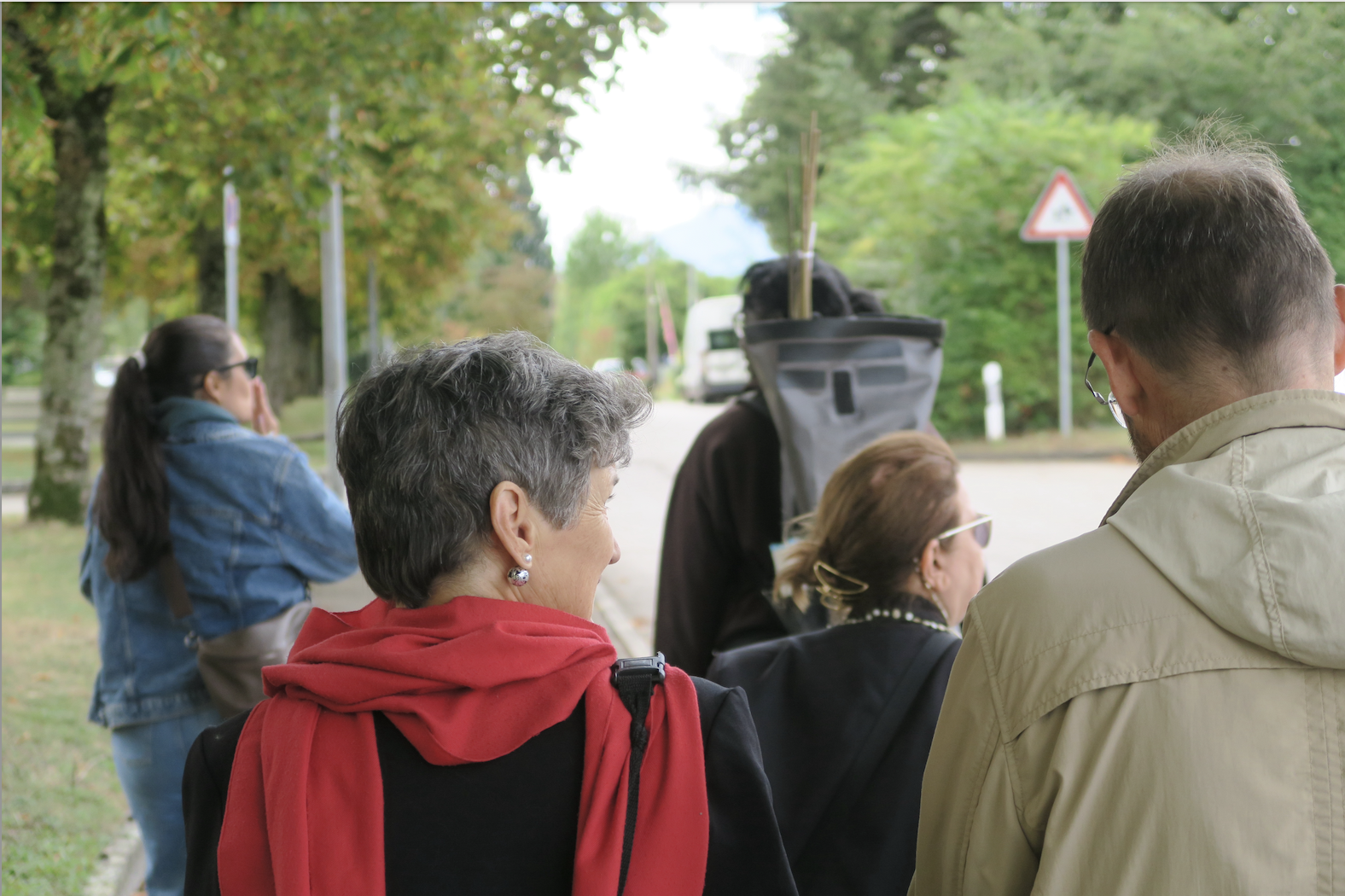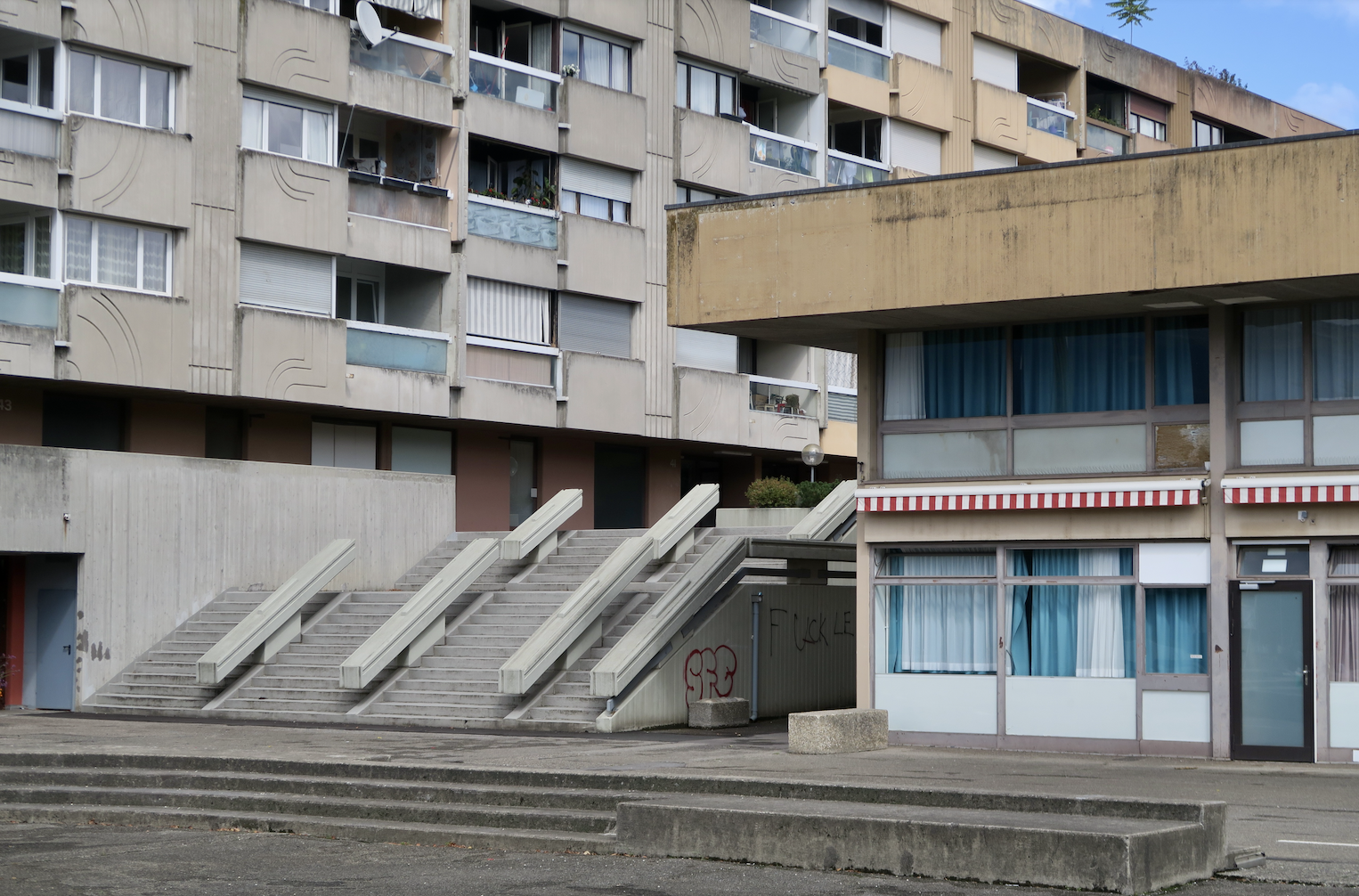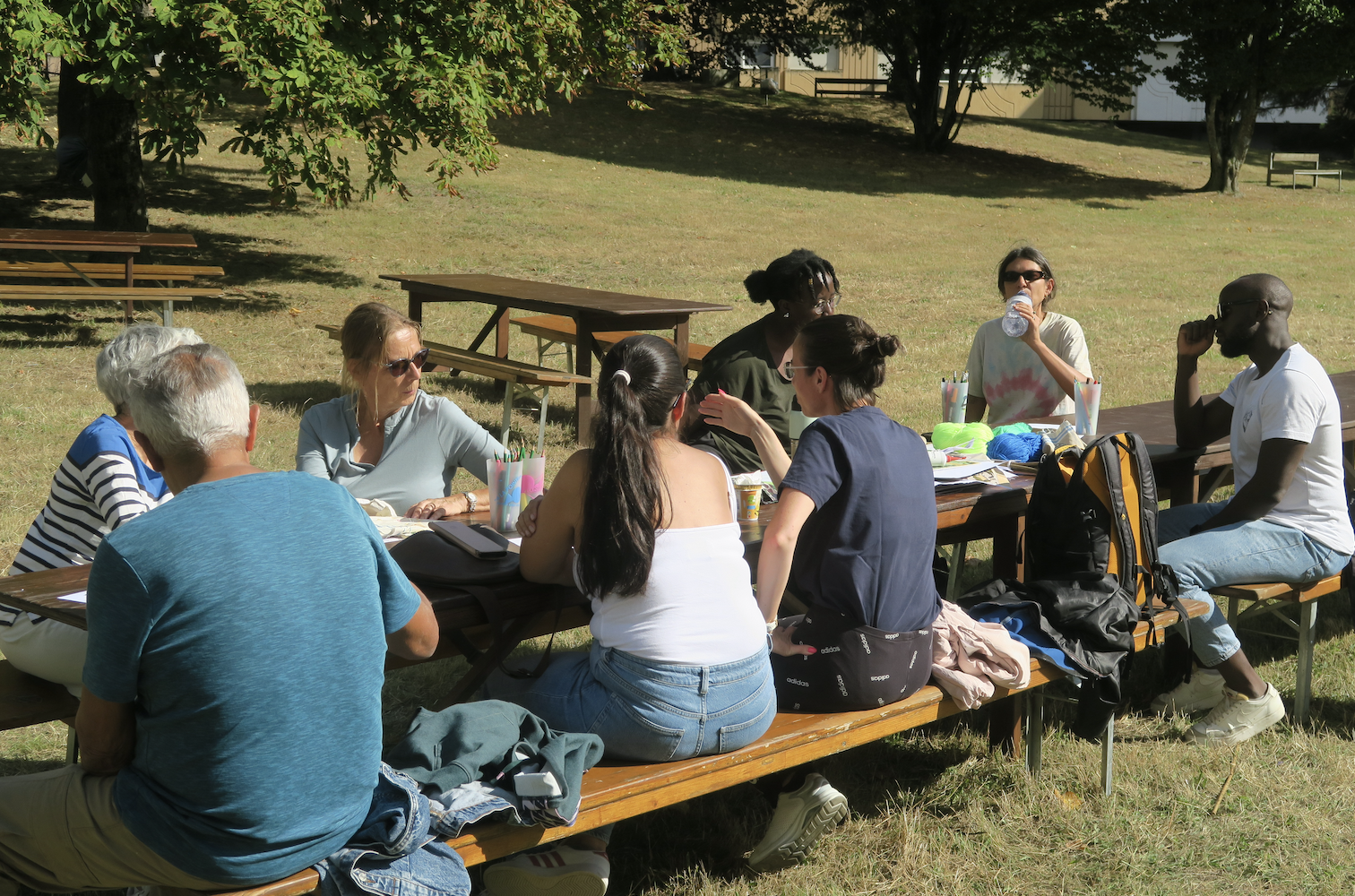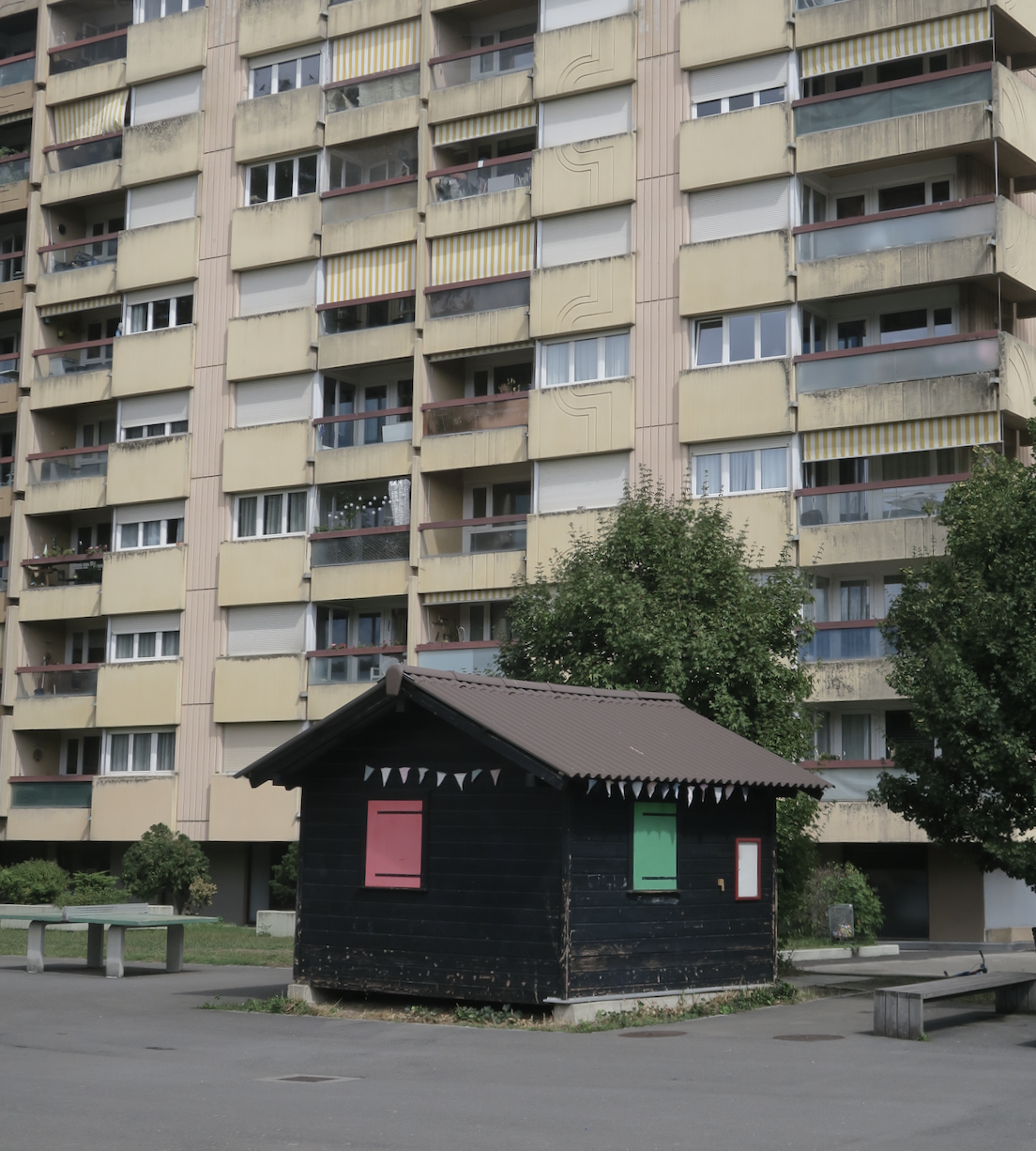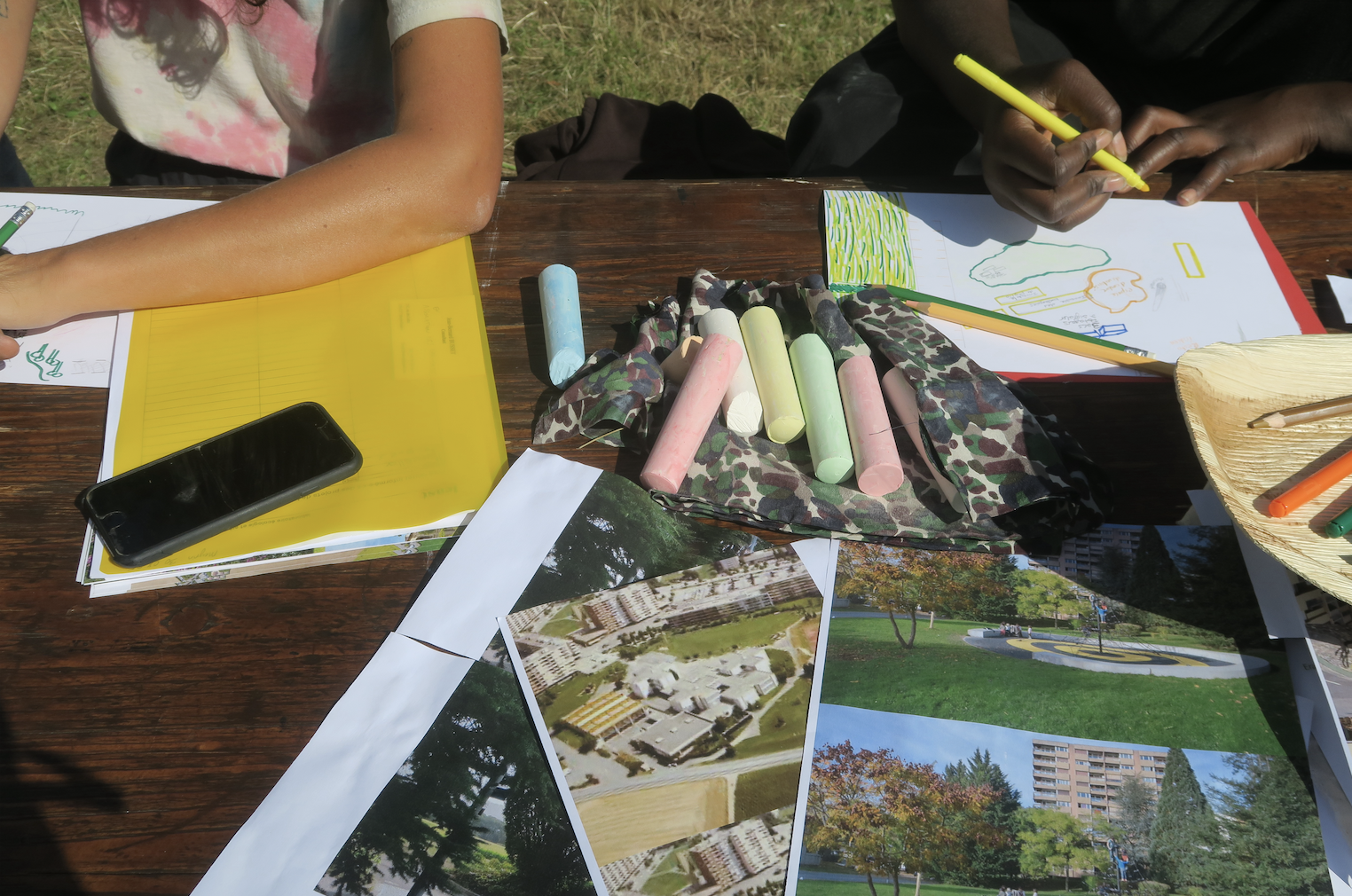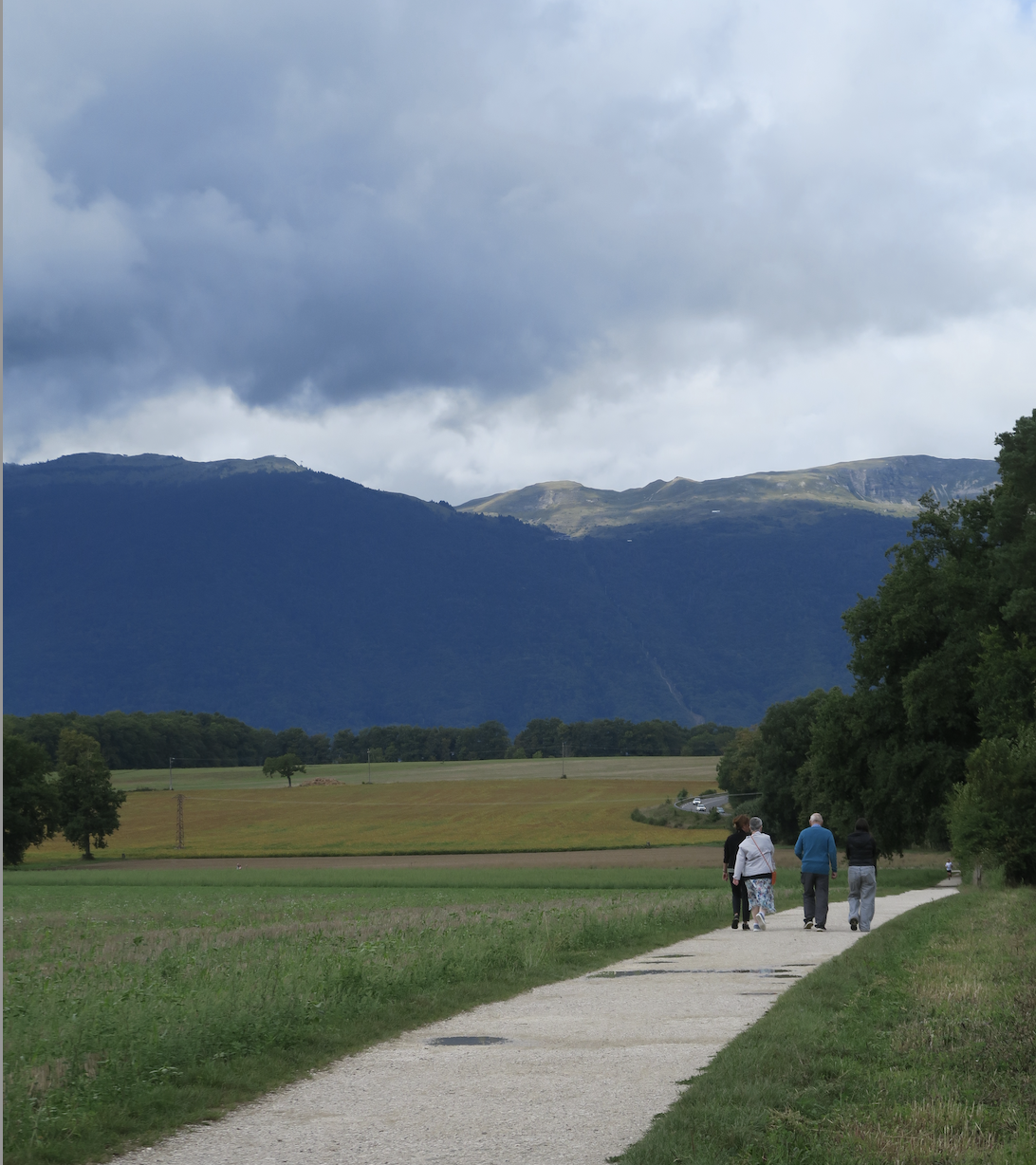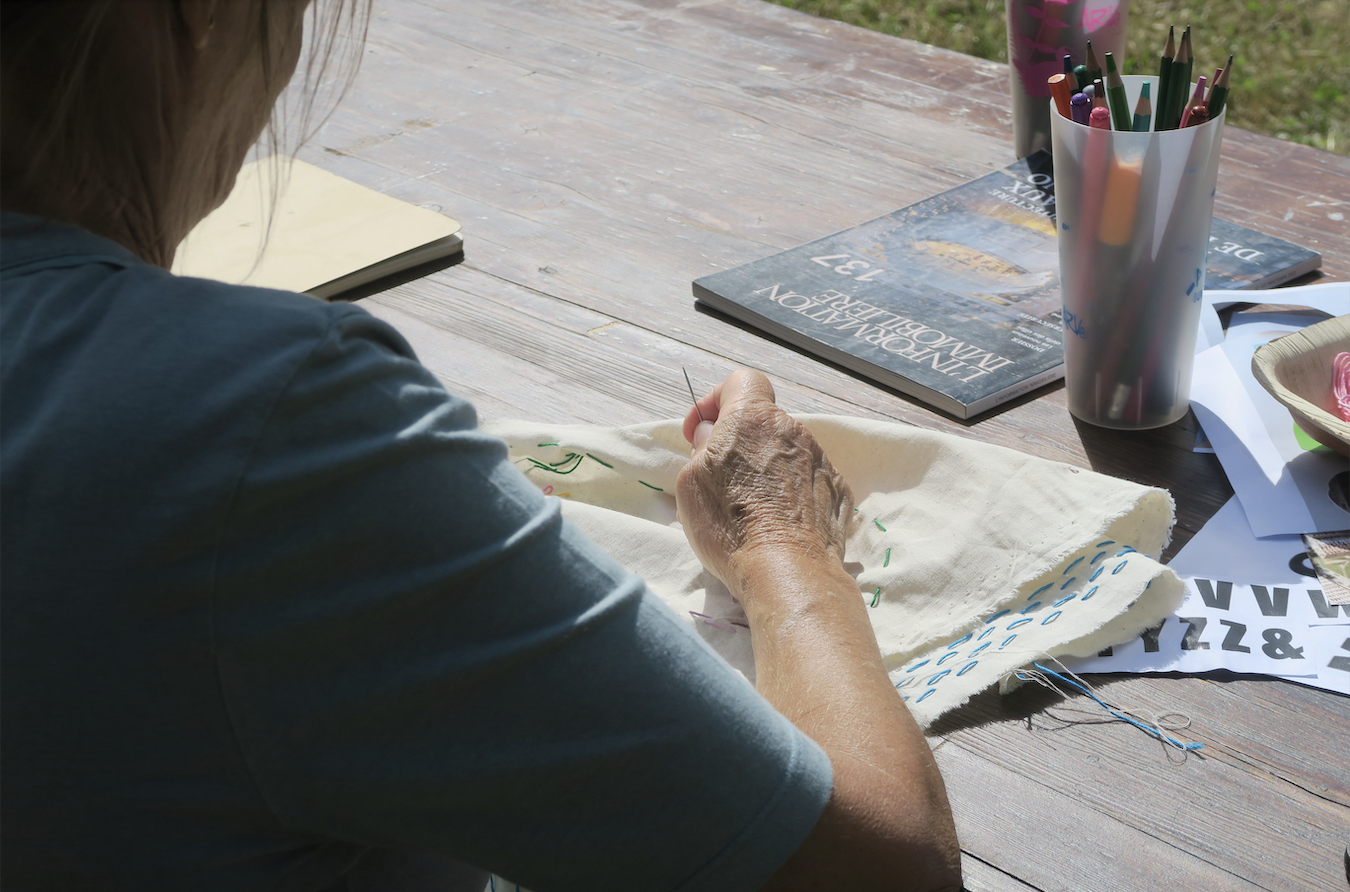laboratoire écologie et art pour une société en transition
Meeting on the Threshold
The Champs-Fréchets neighbourhood holds a singular position: located on the outskirts of Geneva, it straddles the line between city and countryside, just steps from the French–Swiss border. In essence, it is a threshold – a space of transition where dynamic tensions unfold between “one” and “the other”, and where the very notion of boundary invites continuity. How can we foster encounters in this ambiguous, in-between space? How can we sublimate this liminal condition and turn it into a resource?
As part of the efforts to redevelop public spaces and replant vegetation in Champs-Fréchets – a project led in collaboration with landscape architecture firm ECHO – least has invited artist Davide-Christelle Sanvee to engage in a co-creation process with the local community. Through a series of site visits and discussions with key stakeholders, including the Champs-Fréchets residents’ association, the idea of “thresholds” emerged as both a concrete and symbolic starting point for a shared reflection on how public space could be reimagined and better used.
The project invites the public to take part in this collective reflection by gathering around key elements, whether already present or newly created, identified in dialogue with the artist. These anchor points serve as catalysts for connection, sparking new interactions and encouraging fresh ways of inhabiting shared space.
What we’ve done
Through fieldwork based on direct encounters and word of mouth, the project began by strengthening existing ties and bringing out the community’s needs and imaginations, placing them within a perspective of collective and inclusive appropriation of public space. This momentum continued in the summer of 2025 during a creative and festive day at Champs-Fréchets with Davide-Christelle Sanvee, where collage and DIY workshops around collective flags, a walking tour, a meal, and a convivial aperitif allowed residents to share their desires and sketch out the contours of a common future together as part of the neighborhood’s revegetation project.
What we’re doing
The co-creative teams are working on the next stages of the project, striving to combine the wishes and stories heard during the early phases of the project, particularly around the issue of redeveloping the hill and its potential for identity and social interaction.
What’s next
The project is entering a new phase with co-creative workshops bringing together different groups of residents, in partnership with local associations. Led by artist Davide-Christelle Sanvee, they will give a voice to the neighborhood’s iconic locations to reveal their symbolic and emotional significance. These stories will feed into a collective performance, museum panels in public spaces, and a reference tool for urban planners and institutions, in order to imagine the neighborhood in a more human and creative way in collaboration with the ECHO office. The collective work around a flag will also continue, as a symbol of identity and a signal for the hill.
transdisciplinary team
Davide-Christelle Sanvee - artist
Arnaud Gil - landscape architect
Antonella Vitale - architect and resident of Champs-Fréchets
Association of the Residents of Champs-Fréchets (AHCF)
BUREAU - designers
least would like to thank all the people that contributed to the project by sharing their time, knowledge and resources:
Martine Viret (AHCF - Association des Habitants des Champs Fréchets); Commune de Meyrin; Atelier Echo
media
The Life of Lines
Reading
Humans make lines when walking, talking, or gesturing.
Sur le seuil
Emergency and Cocreation
Reading
An interview with architect Antonella Vitale.
Sur le seuil
Devenirs buissons
The Life of Lines
“As walking, talking, and gesticulating creatures, human beings generate lines wherever they go.” This simple yet incisive observation opens Lines: A Brief History, an essay in which anthropologist Tim Ingold lays the groundwork for what he calls a “comparative anthropology of the line.” The book sets out to trace the presence and purpose of lines across a vast range of human activities, revealing how—through varied historical, cultural and geographical lenses—they disclose the ways in which human beings have imagined, enacted and reshaped their modes of life and thought over time.
Ingold’s reflection is grounded in an anthropological approach that places lived practice at its heart. True to this spirit, he invites readers to undertake a small experiment: to imagine — or better still, to draw — a long, meandering line across a sheet of paper, without any specific aim, a line he likens to being “out for a walk.” He then proposes to reproduce this same line not through the fluid continuity of gesture, but by translating it into a series of evenly spaced dots, that are then joined together. The resulting image may appear much the same, yet the embodied experience of producing it could hardly be more different. One is a gesture surrendered to the fluidity of movement; the other, a deliberate act of juxtaposition and connection, demanding a distinct temporality, attention and corporeality. It is in this lived difference—prior even to any formal one—that Ingold’s contrast between wayfaring and transport comes most sharply into view.
These two ways of drawing a line correspond to two ways of moving through the world and of experiencing space: on the one hand, the itinerant journey, or wayfaring; on the other, the directed motion of transport. In the first, the traveller is not compelled by the need to reach a predetermined destination, for the path itself — potentially infinite — holds the very meaning of movement. This is not to suggest aimless wandering. As hunter-gatherer groups demonstrate, one may travel with attentiveness rather than intent: guided by landmarks, attuned to the fruits to be gathered, the traces leading to new resources, the unexpected opportunities along the way, and even the pauses for rest that form an integral part of the journey. In this view, paths are not mere lines connecting two points; they are gradually shaped, becoming corridors of inscription—lived spaces continually rewritten by those who traverse them.
Transport, by contrast, is defined from the outset by a fixed destination and by the aim of moving people or goods “in such a way as to leave their basic natures unaffected.” What matters here is not the lived experience of the journey, nor any attentiveness to what unfolds along the way, but rather the efficiency of transfer from one place to another — so that any personal transformation that travel might provoke is systematically excluded. Intermediate stages, in this logic, are not moments of pause, observation or reinterpretation, but mere functional intervals, measured in terms of technical activity or completion. Where the wayfarer is always somewhere — rooted in a relationship of presence with the environment they inhabit — the passenger in transport, when neither at the point of departure nor at the point of arrival, is nowhere: suspended in transit, stripped of situated experience. Ingold aptly summarises this condition, calling it “the dissolution of the intimate bond that, in wayfaring, couples locomotion and perception.”
This distinction also finds expression in spatial metaphors. The wayfarer, moving along, weaves an irregular mesh that overlaps and intertwines with other lines, forming a fabric that embodies a way of dwelling in the world. Transport, by contrast, conjures a network of interconnected points, in which paths are reduced to functional segments linking predetermined nodes — reflecting less an experience of dwelling than a logic of occupation. These two perspectives are not simply variations on a theme; they reveal profoundly different conceptions of the relationship between movement and space.

Drawing: Anaëlle Clot.
Likewise, representations of space bear the imprint of this distinction. When we sketch a map to give someone directions, what appears on paper is never a mere objective transposition, but the outcome of lived experience — enriched by our stories, memories and the gestures that accompany our explanations. Each mark bears witness to a journey already taken, traced along a “path of observation.” In this sense, lines are not simple graphic signs but traces of movement—the very essence of the sketch, for they both orient and evoke a tangible relationship with the terrain. By contrast, on a modern map, the line loses its narrative and experiential charge, assuming instead a symbolic and normative role: it signifies roads, railways and physical or administrative boundaries, embodying “an appropriation of the space surrounding the points that the lines connect or (…) that they enclose.” The result is a form of cartographic knowledge that does not emerge from the embodied experience of movement, but is constructed by linking distant, abstract points—fragmenting experience and silencing the stories it might tell. It is not knowledge that moves, but knowledge assembled: functional to a system of occupation and control rather than to a process of dwelling and observation. This way of representing space also permeates urban design, structured by limits, predefined routes and thresholds — features that the everyday practices of inhabitants continually subvert or reinterpret.
At this juncture, Ingold makes a decisive turn in his argument. Beneath the different ways of moving through and representing space, he discerns two distinct ways of conceiving knowledge. He shows that our understanding of knowing is inseparable from the gestures and trajectories through which we relate to the world: every form of knowledge, whether explicit or implicit, is grounded in a way of moving, walking or orienting oneself. In contemporary Western societies, the conception of movement as linear, goal-oriented and efficient has gradually shaped a corresponding form of knowledge — one constructed through the linking of fixed points, through processes of organisation, classification and articulation. This is knowledge built by juxtaposition, privileging stability and measurement over the fluidity and contingency of lived experience. To know, in this view, is to accumulate data and to establish abstract relations among discrete elements — a logic of control and planning.
Conversely, conceiving movement as a continuous and open journey invites us to reimagine knowledge as a living process, formed in direct contact with the world, within the temporality of gesture and the reciprocity of perception. Knowing no longer means dominating or representing from without but dwelling within an environment: allowing oneself to be moved by its rhythms and to respond to its invitations. In this light, knowledge emerges as a practice of attention and participation—a dynamic entanglement of perception, memory and invention. It becomes a path of thought which, like the wayfarer’s journey, does not seek a final destination but continually renews itself through its very unfolding.
In this sense, representations of space are not neutral images of the world, but genuine cognitive and relational models: they both mirror and shape particular ways of thinking and living. Contemporary maps and diagrams, by reducing space to a network of functional connections, express a form of knowledge that separates the observer from the world, imposing an external and overarching point of view. Yet the experience of dwelling — woven from everyday gestures, diversions and encounters — reveals an opposing logic: not one of distance, but of proximity; not one of occupation, but of involvement.
The notion of a “pure transport” — a movement linking two points without leaving any trace of transformation — is, for Ingold, an illusion, much like the belief in neutral, disembodied knowledge. One cannot know without being involved, just as one cannot traverse a space without altering it or being altered in return. For Ingold, to know is always to inhabit the world: to engage with it through practice, attention and gesture, weaving with the living a fabric of correspondences and shared stories. It is within this reciprocity, rather than within abstraction, that what he calls the “ecology of life” takes shape: a form of knowledge that does not merely connect points, but follows the very lines of the living, opening itself to the continuity and unpredictability of the inhabited world.
Emergency and Cocreation
Antonella Vitale is an architect who has spent part of her career designing refugee camps. Today, talking about displaced people and temporary spaces is not only a way of addressing humanitarian crises, it also implies a broader reflection about what it means to live and cohabit in a world marked by instability and climate change. The experience gained in these contexts shows that it is possible to meet basic housing needs even with limited resources, by directly involving communities and experimenting with more flexible and appropriate solutions. In refugee camps, co-creation and adaptation strategies emerge that can inspire a more general approach to architectural design. At a time of ecological emergency and forced migration, understanding how to ensure dignified living conditions in precarious situations means questioning the vulnerabilities of our own cities and rethinking the ways in which communities can be involved in the construction of living spaces.
What is the link between ecological emergency and migration?
Environmental problems, such as the scarcity of natural resources, desertification, and ecological disasters, are often closely linked to conflict and migration. The construction of refugee camps also brings its own challenges. For example, a side effect of their presence is deforestation, as displaced people need wood for cooking and, in some cases, their settlements expand. It’s important to remember that these people often live in tents for years and build temporary structures of their own accord.
How long are we talking about?
The average time spent in a camp is 17 years. That’s why humanitarian culture has evolved over time: in the past, we simply provided food, water, and temporary accommodation. Today, the aim is to offer as normal a life as possible. Rather than providing temporary accommodation, the idea is to house displaced people with local residents or in reallocated structures, if the local authorities allow it. Refugee camps do not facilitate integration because they create ghettos; they are now seen as a last resort.
What type of facilities are generally available to these populations?
Tents and containers are among the most expensive options in non-European contexts, if only for transport. Tents, in particular, are very precarious and uncomfortable, and depending on the climate, might only last six months. In addition, camps are often set up on land that hasn’t been built on, and there’s usually a good reason why: it could be prone to flooding, too hot, or impossible to cultivate. In general, it remains crucial to move as quickly as possible from the emergency response phase to a transitional phase, and then on to greater stability.
Have you had any experiences of this kind in your work?
During my assignment in Mozambique, I was involved in extending a refugee camp to accommodate an additional 5,000 people. I took over the project after the departure of my predecessor, who had encountered a number of management difficulties. One of the main problems was the fires lit by the camp residents in protest. When I arrived, the situation was complex, and the safety rules were very strict: I had to respect a time limit in the camp and return to my base before sunset. It was one of my first experiences, and I found myself faced with a major challenge, with no clear guidelines on how to proceed, and few resources.
What approach did you take?
I chose to maximise my time in the camp by starting to interact with the different communities. The camp was home to groups from the Great Lakes region of Africa, people marked by deep-rooted tribal conflict. I tried to understand their situation and involve them in the decision-making process, giving them the task of pointing out problems and essential needs. If I hadn’t done this, there would probably have been opposition, because unwittingly, for example, we would have exacerbated enmities between clans by intervening in stories we couldn’t understand, and fuelling tensions.
What strategies did you use to involve the camp residents?
The key moment was the launch of the design and planning phase. I let the residents tell me their needs, aspirations, and preferences for the layout of the homes. For me, the most important thing was to respect the number of people to be housed, while the distribution of the spaces was up to them. This approach had a very positive impact on the feasibility of the project. My constant presence in the camp also helped to deconstruct the prejudice that international aid workers are distant, locked away in their air-conditioned offices or jeeps. By showing that I was willing to listen, I fostered a climate of trust.
How did you overcome the language barrier?
To facilitate communication and mutual understanding, I chose to display the project drawings in visible places in the camp. This aroused the curiosity of the residents, who approached me for information in order to take an active part in meetings. Thanks to this method, we were able to better define the distribution of living spaces according to the real needs of the community. In the end, the key element of this experience was not the technical aspect, but the ability to listen and respond to people’s needs, initiating a process of co-creation that made the project more effective.

Drawing: © Anaëlle Clot.
How did you intervene in public spaces?
The camp included empty areas that served as natural gathering points, such as those around the water pumps, often located under large trees. One of these points was close to the therapeutic feeding centre for children under five and not far from the school. I analysed these existing synergies and integrated them into the creation of a sports field, strategically positioned to encourage physical activity and movement.
In addition, in this area I introduced a more structured communication system, using a tree as a display point for comments, suggestions, and complaints from the community. Although there was more criticism than praise, this system established a clear and direct channel of communication. My aim was to facilitate discussions between the operators and the community, gathering useful feedback to improve the management of the camp. When there’s participation, co-creation or at least an exchange of ideas, people are willing to get involved, especially if it has to do with buildings or the use of space.
How much freedom was there for self-designing buildings?
In Mozambique, we involved people in the construction of houses using local materials: reeds, earth, and straw. Each family was provided with the same quantity of materials, and they could then decide how to use them by appropriating the project. The idea was to move on from tents to very simple but permanent houses, in line with Mozambican standards. It’s also important to bear this in mind: when offering an emergency solution to a population from outside the country, you mustn’t go beyond what the most disadvantaged members of local society have, so as not to fuel tensions.
Are there other levels of co-creation that are desirable in such a context?
Before leaving their country of origin, displaced people had a trade, occupations, and passions. Mapping these skills is an asset that can be exploited to the full, firstly to integrate these people into the world of work and make them self-sufficient, and secondly to contribute to aid programmes for displaced people. Since resources are limited, taking advantage of local skills is a great opportunity. It’s not always easy, it takes time, and you have to meet people, but it’s of enormous benefit to the community, which feels respected rather than marginalised.
Are there any spontaneous practices in the public space that help to foster cohesion?
Food is an important tool of cultural identity, especially in contexts of great disorientation. The opportunity to grow traditional foods not only provides a means of subsistence but also enables people to maintain a link with their culture of origin and share it with the local population. This practice creates opportunities for cultural exchange, for example through small food outlets where camp residents can share their cuisine. It can also facilitate the exchange of agricultural or culinary techniques useful to both the refugee and host communities.
What is the relationship between emergency and planning?
Emergency and planning are almost antagonistic, because in an emergency situation, by definition, there is no time or opportunity to plan. However, we mustn’t fall into the trap of continuous emergency either, as that would be naïve, costly, and politically dangerous. In an emergency, many rules have to be waived. Legislation requires time, strict processes, and co-creation, but it is also the only way forward.
What can we learn from housing in emergency contexts?
In emergency contexts, we learn that delaying action progressively reduces the options available, until none are left. Today’s multiple crises, including climate change, teach us that it is essential to act in time, even in Europe, where, despite resources, cities are not ready to face current and future environmental challenges.
In some parts of the world, climate crisis is gradually rendering entire regions uninhabitable. The problem is not just rising temperatures, but the disappearance of vital resources, forcing people to migrate. However, global attention is more often focused on protecting against migratory flows than on long-term interventions to prevent crises.
press
A new look for Champs-Fréchets
Meyrin Région, summer 2025
